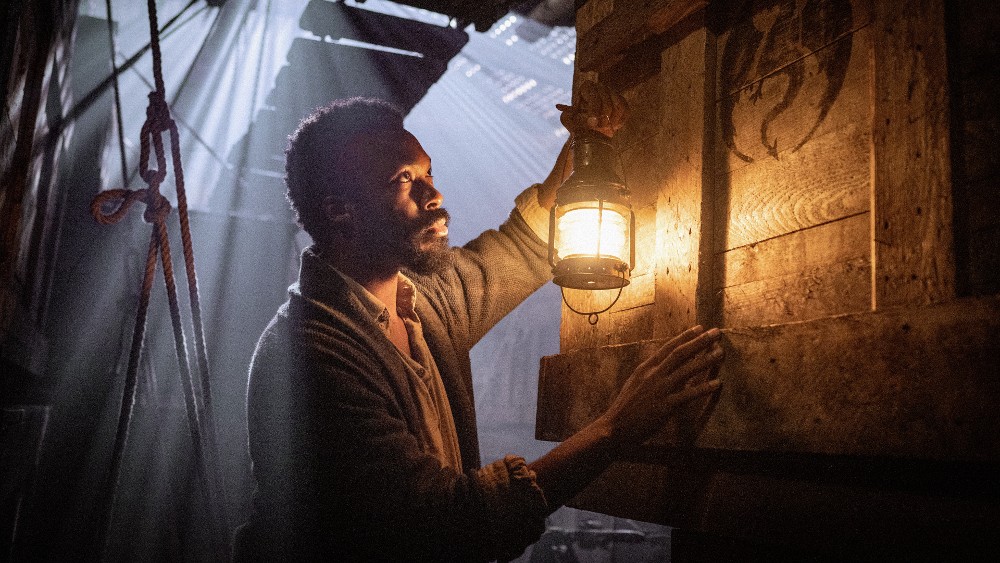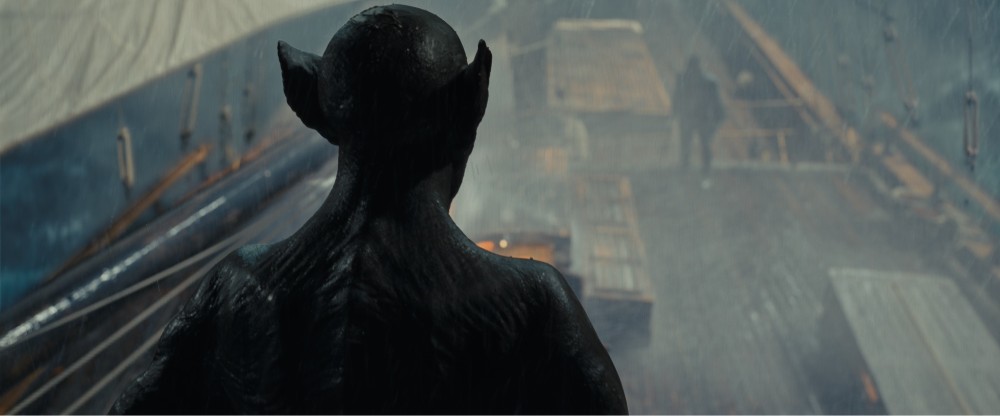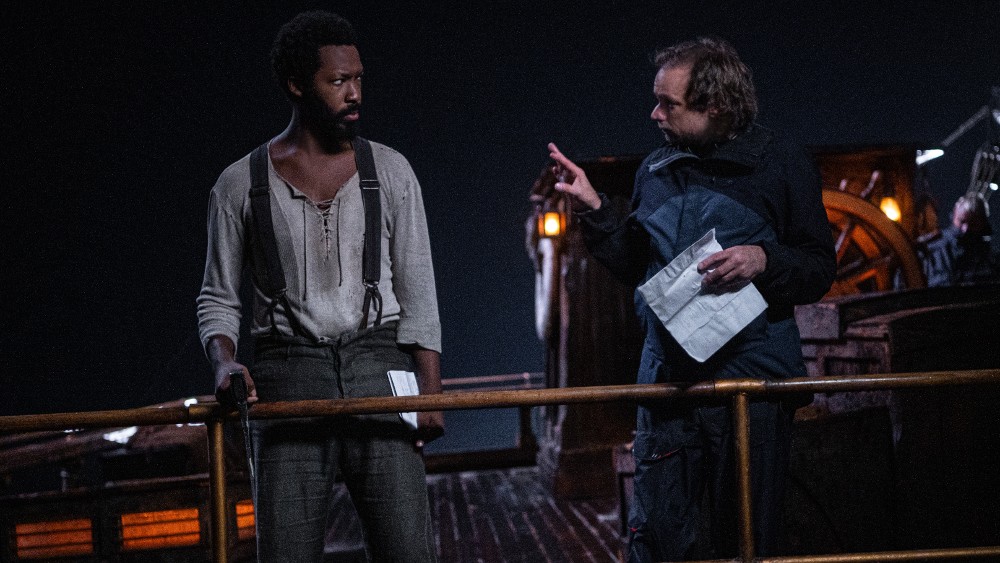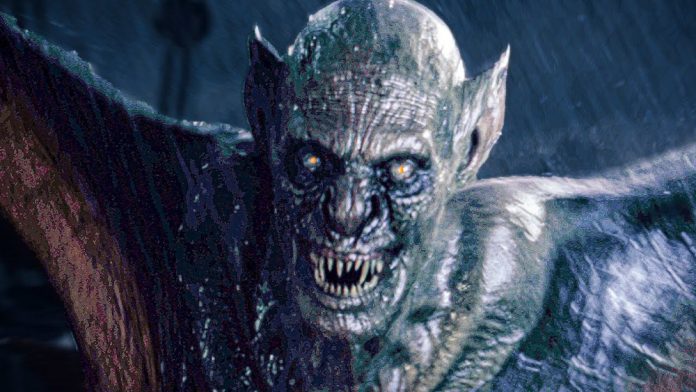In 2010, Norwegian filmmaker André Øvredal burst onto the genre scene with his second feature, Trollhunter, which led to making movies in the States. Øvredal’s creepy 2016 horror-thriller The Autopsy of Jane Done starring Emile Hirsch and Brian Cox earned him a call from producer Guillermo del Toro, who brought him aboard the 2019 adaptation of Scary Stories to Tell in the Dark, based on the beloved books by Alvin Schwartz.
Øvredal returns to theaters this weekend with The Last Voyage of the Demeter, which marks Universal’s latest exploration of the mythos behind Bram Stoker’s Dracula. The film is based on “The Captain’s Log” found at the beginning of Stoker’s classic novel, and it covers the killer Count’s long journey from Romania to England, where he continued his reign of vampiric terror. 1922’s Nosferatu and 1931’s Dracula movie both featured the Demeter, as have other iterations of the story, though the cursed sea voyage is typically glossed over and given just a few minutes of screentime. The Last Voyage of the Demeter, however, gets into all the gory details.
The film stars Corey Hawkins (Straight Outta Compton) as Clemens, a British doctor who fights for a job aboard the Demeter in order to return to the UK, though the captain (Liam Cunningham from Game of Thrones) and his first mate (David Dastmalchian from Ant-Man) are dubious of him. Their suspicions grow when a pretty young stowaway (Aisling Franciosi, also from Game of Thrones) is found on the ship and Clemens discovers she has a mysterious ailment. Soon, the entire crew (as well as the captain’s young son, played by Woody Norman from C’mon C’mon) are stalked by a mysterious creature with a taste for blood.
Above the Line recently jumped on Zoom with Øvredal to talk about The Last Voyage of the Demeter and how his more creature-like version of Dracula (as played by Hollywood’s go-to creature performer (Javier Botet) was conceived and created.

Above the Line: I think I read that this opportunity came about because Guillermo del Toro was busy doing something else, and he recommended you for it, right?
André Øvredal: Yeah, he was kind enough to recommend me to Amblin to direct the movie. It was a big part of the reason I got it, I’m sure, but I was also working with Brad Fischer, one of the producers, on another Stephen King-based movie at the time [Note: It was an adaptation of the Richard Bachman novel The Long Walk for New Line], and this just happened and then suddenly everything just kind of fell into place.
ATL: What was it about the script that interested you in this world, which operates like a prequel to Dracula even though it’s really part of the beginning of the original Dracula story?
Øvredal: It’s an amazing world to be able to play in. To be part of the legacy of all these great movies that have been made in the past [from] the Dracula novel is an opportunity of a lifetime. You can never not say “yes” to that — that would be the dumbest thing I would ever do. It was an exciting, challenging, amazing movie to direct on every level, from getting the right characters and casting it [to] shooting it and getting the right cuts, and [then] all the VFX and all the physical effects. It was an amazing experience that I feel like I’ve grown from.
ATL: So you were involved early on enough to work on the script and be involved with the casting on this?
Øvredal: We worked on it for a year before we went into production, more than that. I spent six months with Zak Olkewicz at the beginning of the pandemic [just] working on the script, to basically write our version of it. It’s still the same story that Bragi Schut wrote. It’s just lots of new details and lots of new elements, and as a director, of course, I’m part of casting — I cast the movie with the studio and with the producers.

ATL: Tell me about that process, because this is such an interesting cast with many different characters, but you also have a kid in there, the talented young actor who starred in Mike Mills‘ C’mon C’mon, plus a couple of Game of Thrones vets as well. I guess we can start by talking about Corey…
Øvredal: Corey was just like, ‘Who do we want for Clemens? Who can portray the intelligence and the warmth and everything that Clemens needs to be?’ Corey, his name came up very quickly, and we sent him the script, and he loved it. We talked and we agreed, in a way, for him to join the journey. And then the rest… Liam, I remembered having a conversation with early on; he enjoyed the captain’s part.
I was happy with that, [and] Amblin was open to the idea of casting the best actors we could [rather than] wait for some name, [which] could delay the production. We all wanted to make the movie, and we had great characters that these wonderful actors were leaning into. We were just able to go out and cast whoever we wanted, in a way, and that was such a wonderful process.
ATL: Woody Norman is the only child on the whole set, and this movie has a far darker tone than C’mon C’mon, so did he enjoy seeing the gore or did you try to shield him from some of the film’s more R-rated elements?
Øvredal: He’s such a professional already at his young age, and gore, when you’re making the movie, gore isn’t gore. It’s so technical. It becomes about the little bucket with stuff and that needs to work and it needs to spray, and it needs to do this. He’s not really part of most of those scenes anyway, so he wouldn’t be on set when we were shooting that, just naturally. But he’s a star to work with, a brilliant actor, and gave some really gripping moments in the film, I felt. He did wonderful, and he loved being part of the journey.
ATL: Were you doing most of this during COVID? I feel like the movie may have been delayed due to COVID, or is that not the case?
Øvredal: Not necessarily because of COVID. We had an earlier release date that we were looking at in January this year. It was a date we didn’t want. We always felt it would probably play better as a counter thing to big, shiny movies in the summer. We were very happy when Universal found us a new date in August, so that was just a thing to get better placement in the year.

ATL: While you were working on the script, were you also working with designers on things like the look of the ship and how Dracula would look to help inform your writing process?
Øvredal: Yeah, it all went at the same time, the design of Dracula and the design of the ship, and just hiring crew and finding the right people to collaborate with throughout the whole process.
ATL: Obviously, most of it takes place on a ship, so you can build the ship on a stage somewhere, but there’s also the water aspect of it. Did you end up using a tank for most of the shoot, or did you create the water with visual effects?
Øvredal: We shot first in Berlin for a few weeks to shoot all the interior scenes. We built the whole interior with the cargo hold and all the rooms they’re occupying, and then we went to Malta to their tank, [which] is actually one that Ridley Scott tends to use, and we shot there for a month and a half, two months — first in [the] daytime, shooting all the daylight scenes, and then we went into night shoots for six weeks. That was an amazing experience. [It was] kind of crazy to be on that ship, day in and day out, night in and night out.
ATL: Did you build portions of the ship on the tank as well?
Øvredal: In Berlin, that was all one big piece, basically, and the same, we built the whole ship, physically, not pieces of it, the whole ship in the tank. With the hull and the deck and everything intact. That was a wonderful set to be on. We just kind of lived there.

ATL: Let’s talk about the creation of Dracula. You have Javier Botet, who you worked with before, and the character goes through an evolution throughout the film. There are many different types of Draculas, from the suave elegance of Bela Lugosi to the Max Schreck version, which is more like a creature and less human.
Øvredal: I was fascinated by the fact that Dracula is ancient, he’s hundreds of years old. He’s a human being who’s lived through enormous changes in the world and he’s killed more people than we’ve met. I found that to be a fascinating aspect that I wanted to see texturally on him, that he has lived this life.
In addition, I wanted to show the evolution into this bat creature in a way that felt somewhat natural. We were looking at bats more. We didn’t really look at movie references, we looked at what is real, and how would a really old person like that look? How would a bat move? How does a bat expand its wings? How does the membrane of the wings look? How does the muscular setup work? Everything was built and created with that in mind.
ATL: Were you able to watch the movie with the cast and bring everyone together to see it before the strike?
Øvredal: No, we had to cancel our premiere because of the strike, but our cast is worldwide — they’re all over the place — so to put them together in one room is a huge endeavor. We had a premiere date for us that was just canceled some weeks ago. That’s sad, but that’s just part of the process when you’re dealing with such big politics.
ATL: Can you get everyone together on Zoom in front of a big screen?
Øvredal: That might be a solution. We’re looking into something.

ATL: They just showed Trollhunter at the theater around the corner from me, and I realized that movie was so full of humor, as was Scary Stories to Tell in the Dark. Is it harder to work on a movie that’s just so much darker and has no room for humor, simply based on its nature?
Øvredal: It is dark, but then on a daily basis, when you’re working, hanging around the set, you’re chatting, and you’re having fun, and you’re joking. It doesn’t affect the day-to-day thing, except for when you’re doing really difficult scenes, because there’s a lot riding on those scenes working. That will [happen with] any movie, even if it’s a comedy or whatever it is — if the scene is difficult, then it will be harder. I have been thinking about it lately… maybe my next movie should have a little bit more levity.
ATL: What would you say to people who haven’t seen the movie who tell you, “Oh, I’ve already seen Dracula.” What would you tell them about what differentiates The Last Voyage of the Demeter from all the other Dracula and vampire movies that have come before it?
Øvredal: I would tell them that this is really just a scary movie, the way you love scary movies. You want to go and get frightened, existentially and physically, and with jump scares. And additionally, it is Dracula in a way you’ve never seen him before — a totally unique take, but also truthful. It’s not a revisionist take on Dracula; it’s based on who he is in [Bram Stoker’s] novel. In my opinion, it actually stays true to the source material.
ATL: Well said. Did I read that you’re going to do another Scary Stories to Tell in the Dark movie? Since CBS Films has folded, would that be with Lionsgate? Have they expressed interest in doing it once the strikes are over?
Øvredal: I mean, it’s there. It’s a conversation we were having until the strike hit us, so I’m curious to see where that ends up after the strike.
ATL: Do you think Guillermo is going to be involved with that, too?
Øvredal: I mean, in some capacity, I would imagine. I would hope…
Universal Pictures will release The Last Voyage of the Demeter on Friday, Aug. 11, with previews beginning on Thursday night.



